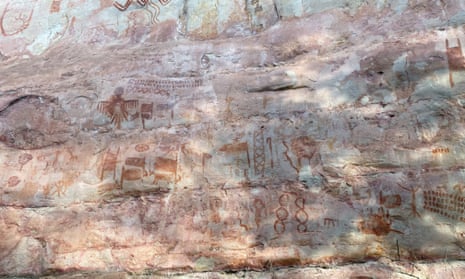In the past week, remarkable images of ancient cave art have hit the headlines: rock paintings made in South America around 12,000 years ago. The art, created on rock faces in the Serranía de la Lindosa, on the northern edge of the Colombian Amazon, is a riot of ochre-coloured geometrical pattern, handprints, and images of animals and humans. Until recent excavations, the works of art had been unknown to the international community. Their exuberant creativity will soon be revealed to a broad audience in the UK thanks to the Channel 4 series Jungle Mystery: Lost Kingdoms of the Amazon.
The people who made these works of art were, it is believed, among the earliest humans to occupy the region, after migrations across what is now the Bering Strait some 25,000 years ago. Preliminary study of the iconography of the art has led scholars to speculate that among the deer, tapirs, alligators, bats, serpents, turtles and porcupines, long-extinct megafauna are also represented: mastodons, American ice-age horses, giant sloths, camelids.
This creativity, this 12,000-year-old print of human hands, and this extraordinary depiction of long-extinct species, is remarkable and moving. But the ongoing archaeological studies in this area may also begin to tell an important story about the environment – and how humans have interacted with the precious Amazonian rainforests. The archaeologists, a team led by Francisco Javier Aceituno of the Universidad de Antioquia, Gaspar Morcote-Rios of the Universidad Nacional de Colombia and José Iriarte, of Exeter University, also discovered stone tools and animal and plant remains, all of which add to the knowledge of the region – and suggest many questions, too.
The extinction of the megafauna is itself an intriguing problem: was it caused by climate change, by humans hunting them to extinction, or by a combination of factors? No megafauna bones were found at the sites investigated, so the people who painted the rock faces were either not big-game hunters or dealt with the carcasses of large animals elsewhere.
What has been found, however, is evidence of many species of useful plants, including 10 species of palm; the researchers think that these people may have been beginning to manage the forest – not just adapting to it passively, but changing it. By around 4,000 years ago, scholars have recently shown, communities in the forest were fertilising soil, planting Brazil-nut trees and chocolate, and clearing land in a very limited way for crop cultivation. These communities, much more populous than previously assumed, achieved food security and were well-nourished – and their presence actively promoted the astonishing biodiversity of the rainforest. Their direct successors are today’s indigenous populations whose existence is so cruelly threatened. The glorious ancient cave paintings are not just a spectacle, they are the roots of a way of life that human greed has done its best to destroy – but on which the ecological richness of the Amazonian forest, and in turn all of humanity, depends.








